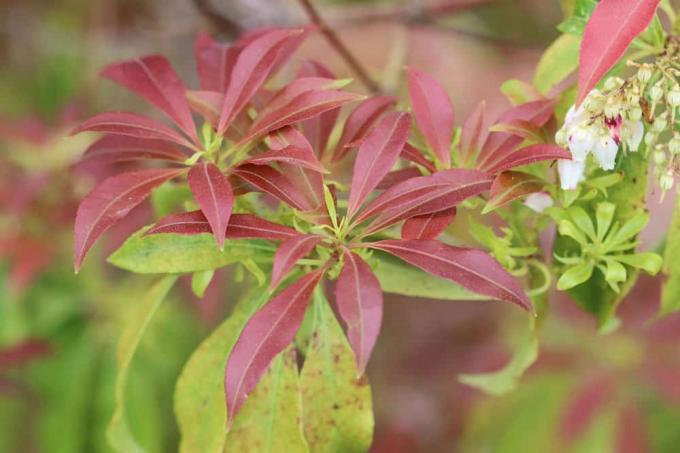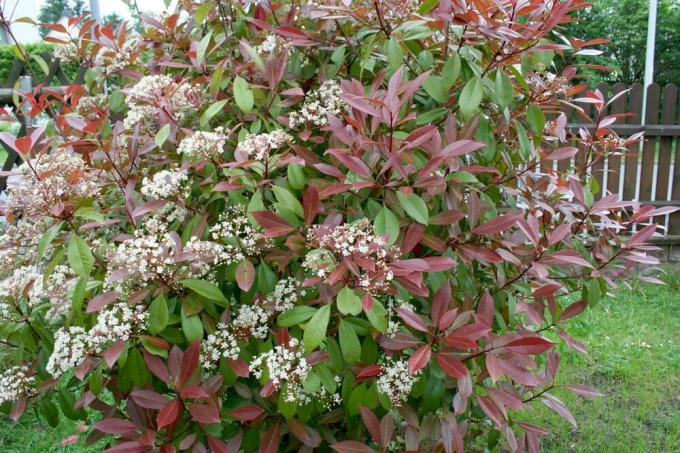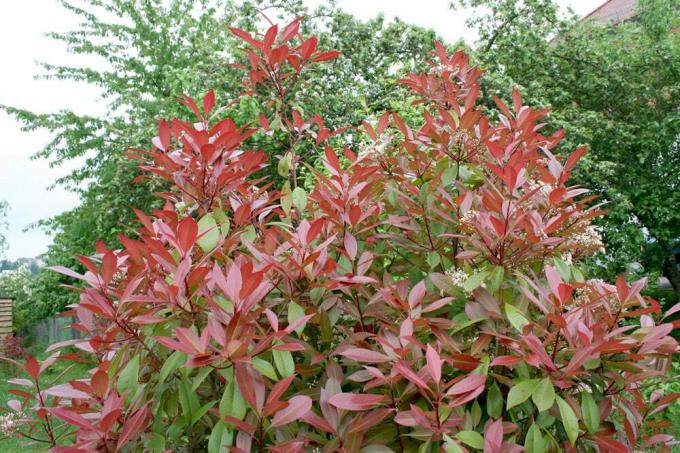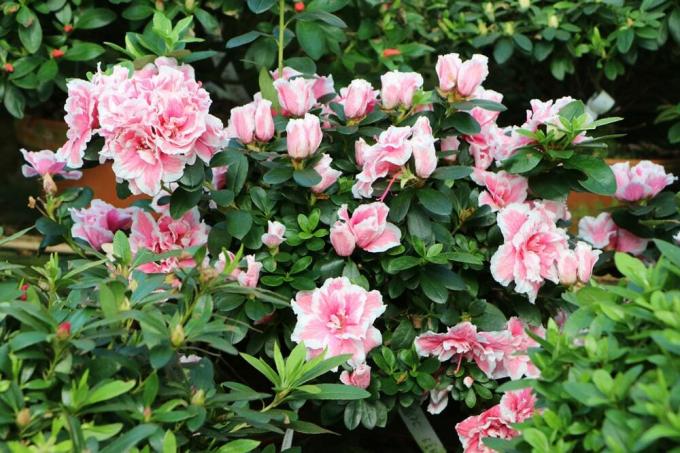

Table of contents
- Plant
- Location
- Floor
- Pour
- Fertilize
- Cut
- hibernate
- plant combinations
- multiply
- seed
- cuttings
- diseases and pests
- Editor's conclusion
- Worth knowing about the photinia "Red Robin" shortly
The medlar (Photinia fraseri) "Red Robin" is a distinctive, evergreen topiary whose leaves sprout red in spring. Grown as a standard, it is a colorful gem with its white flowers and the red berries that develop from them. Many lovers of the photiniae put a plant in a bucket on the right and left of the entrance. The plant, which originally comes from New Zealand and grows to a height of up to 3 m, is easy to care for. However, important points must be observed when cutting the high stem.
Plant
The planting of the Photinia fraseri is best done in spring so that the plants can grow well until winter. Bale goods are very suitable for this because they are easier to plant. The planting hole should be 1.5 times the size of the medlar root ball. After digging the planting hole, first fill in a soil mixture loosened with humus before inserting the medlar. Do not plant the tall stem too deep. The upper edge of the ball must be level with the surface of the garden bed or the potting soil. Tread the plant substrate firmly and water thoroughly.
Tip:
Before planting, soak the root ball in a bucket of water until no more air bubbles rise. The roots need to soak really well to get a good start on growing.
Location
The standard medlar likes sunny to semi-shady locations in a wind-protected area. In shady areas, the development of flowers and berries suffers and the foliage does not change color as beautifully.
Floor

Humus-rich and well-drained soils are preferable for the standard medlar "Red Robin". When planting in a bucket, you can also mix commercially available potting soil with hummus. This is tolerated just as well by the standard medlar. The soil may be calcareous, alkaline, acidic or neutral. It must not form any waterlogging, as this can rot the roots. In addition, the foliage is then dropped prematurely.
Pour
Water the photinia regularly and plentifully for the first 2 weeks after planting. After that, it is sufficient if you only water as soon as the surface of the garden soil or the plant substrate in the bucket has dried. It is best to test the soil moisture with a finger. If the substrate gets stuck, the soil still has enough moisture. When watering, however, make sure that the soil is neither too wet nor too dry. Choose the golden mean here.
Tip:
If the standard medlar is in the bucket, it should always be ensured that the excess water can run off.
You should therefore regularly remove the water from the saucer or place the plant pot on its feet from the outset. These are commercially available in various shapes, sometimes with funny animal motifs.
Fertilize
It is best to fertilize the medlar in the bucket in spring with a slow-release fertilizer or commercial liquid fertilizer. For standard medlars planted in the garden, some compost is sufficient in spring, which is lightly worked into the garden soil.
Cut
High stems must be trimmed regularly to keep them in good shape, otherwise they will grow back into bushes. To do this, first remove any hanging branches of the photiniae, but leave young shoots that branch off from them. Then look at the branches that are still upright but bare. Cut these off at the base. This encourages the standard medlar to form fresh, new wood in the following year and the crown becomes more compact. This gives it a beautiful, spherical, aesthetic shape. Do not leave any branches that grow upwards or to the side from the spherical crown. Remove weak wood and cross shoots from young wood. It is always cut to just above an outward-facing bud.
Tip:
Always cut the tall stem of the photinia with sharp and germ-free pruning shears or pruning shears and always make sure that none of the branches tear.
Because injuries can be entry points for pathogens. It is best to seal larger cuts from the outset with a commercially available wound sealant that also repels pathogens and fungi.
hibernate

The photinia is hardy down to a temperature of -20 °C. Young plants in the garden and in the bucket need winter protection. Pack the plants well in leaf soil, jute sacks or brushwood. You shouldn't expose Red Robin in the tub to much winter sun. It is therefore advisable to overwinter the potted plants indoors at 10 to 15 °C or fully wrapped up in a sheltered spot on the patio. Remember to water regularly even in winter, but not as often and a little more sparingly than in summer. Even high-stem trees in solitary plants in the garden must be watered in winter.
plant combinations
As a standard, medlars have a tree disc that can be planted, for example, with early bloomers and year-round ground covers such as periwinkle or false strawberries. But astilbes, dwarf irises and dwarf columbines are also beautiful plants for underplanting. An equally beautiful arrangement results for the standard medlar with flowering shrubs and perennials nearby.
shrubs:
- forsythia
- cherry laurel
- mock orange
- Deutzia
perennials:
- scented phlox
- perennial marguerite
- scabioses
- knapweed
multiply
Red Robin can be propagated either by seed, cuttings or layering. Whereby the sinkers are taken from a bush-shaped medlar, since the path from the crown to the ground is very long in the case of the standard tree.
seed
You can take the seeds from the berries of your own Photinia fraseri in the tub or garden. It is best to sow them in a so-called cold box or in a cold cold frame and overwinter them there frost-free. Straw mats and styrofoam plates are suitable as winter protection for the boxes. From May - after the ice saints - plant the little plants at their destination.
cuttings
- cut head or shoot cuttings in summer
- or use clippings from the topiary
- Cuttings should be slightly woody
- Shoot cuttings no longer than 15 to 20 cm
- Head cuttings no longer than 8 to 10 cm
- remove all but three pairs of leaves
- Stick the cuttings up to 3 cm deep in the potting soil
- either on the spot or in seed pots
- Pour lightly and put a foil bag over it
- Air foil bags regularly
- put in a shady spot
- Cultivation in pots overwinter frost-free for at least 2 to 3 years
diseases and pests

Apple scab, aphids or vine weevils can sometimes attack red robin high stems. Horsetail tea is used as a plant tonic and the leaves affected by apple scab are burned. If the infestation is very severe, it is unavoidable to use a scab control agent. However, you should do as much as possible without chemicals so as not to destroy the natural balance in the garden. The best way to fight aphids is with garlic, nettle, horsetail or neem spray. The larvae of the vine weevil are fought with nematodes that are administered via the irrigation water.
Editor's conclusion
The photinia "Red Robin" does not require such demanding care and is very tolerant of pruning. With the annual topiary in June, however, you should make sure that the crown gives a nice shape. Red Robin as a standard is a beautiful solitary plant, but also harmonises well with perennials, flowering shrubs and ground cover.
Worth knowing about the photinia "Red Robin" shortly
location and care
- The photinia Red Robin is beautiful to look at all year round. As a standard, the plant looks good in a planter.
- You can also plant a high stem in the bed. The photiniae makes hardly any demands on its location and care.
- It is a popular woody plant and does well as a solitary plant.
- The photinia Red Robin can be used well as a topiary. A bullet works best.
- Cut into shape in this way, the plants are best used in pairs to adorn a house entrance.
- The plant likes a sunny to partially shaded location. The soil should be nutrient rich.
- Winter protection is recommended for the first two years after planting.
- Depending on the size, such a high trunk costs from around 50 euros.
cut
- The photinia Red Robin is easy to cut. It is a topiary.
- The best time for pruning is just before budding, i.e. around March.
- You just cut back the branches, shorten them.
- This will make the shoots thicker and better support the plant's weight.
- A regular cut keeps the photinia "Red Robin" in shape.
- The branches and twigs do not need to be supported.
- You have to wait about two years after planting until the photinia really starts to sprout and grow.
- It needs this time to root properly. After about two years, it should also be pruned so that the crown becomes nice and dense.
- The outer branches are cut harder than the inner ones.
- Medlars also sprout well from old wood, which is why you can't do much wrong when cutting. The plant forgives pruning mistakes and usually drives out again willingly.
- It is best to cut back to an outward pointing eye (bud).
Tip:
To be on the safe side, cuts that are larger than a 2 euro piece should be treated with a wound closure agent, e.g. B. with Malusan. The remedy is applied to the cut. It prevents germs, fungi and the like from penetrating.
 garden editorial
garden editorial I write about everything that interests me in my garden.
Learn more about shrubs and woody plants

17 flowering hardy plants May to October
Many plants only show their full splendor for a short time. But there are also types and varieties with a particularly long flowering period from May to October, sometimes even longer. We present 17 flowering hardy plants.

25 hardy and evergreen ornamental trees
Ornamental trees are among the most popular plants in the garden. They have a decorative effect and set special accents in the green oasis. If you are tired of the gray of the cold season, you can plant trees that are hardy and evergreen.

Is barberry poisonous? | What is to be considered?
With their dense growth, numerous thorns and evergreen foliage, barberries are one of the most popular types of plants for a hedge in the garden. Before cultivating the sour thorn family (Berberidaceae), many ask themselves whether the plant is poisonous.

Azalea location: 6 important criteria
Azaleas are a flowering addition to the garden or living room, as long as they are in the right location. In the following guide to azaleas, we will tell you what to look out for.

How fast does a rhododendron grow? | Information about growth
How fast a rhododendron grows depends on various factors, including the variety, location and care. Growth can be accelerated under optimal conditions, while deficiencies lead to stunted growth.

Butterfly bush: the ideal location | Buddleia
The uncomplicated, easy-care and robust butterfly bush is suitable in the garden for borders, a flowering hedge or as a solitaire. Dwarf summer lilacs are ideal for pot culture. Buddleia bloom from June to October and are a magnet for many butterflies.



